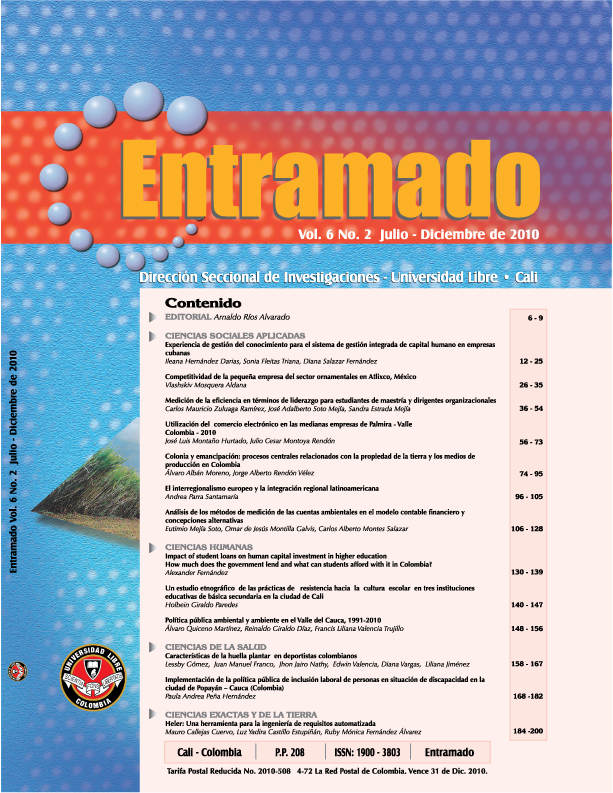Heler
A tool for automated requirements engineering
Keywords:
Requirements Engineering, unified process, requirements, software specifications, free softwareAbstract
This article presents the results of a research study carried out in order to implement the HELER (from its Spanish acronym “Herramienta Libre para la Especificación de Requisitos”) tool (free tool for specification of requirements) which supports the activities of requirements engineering during the stage of understanding a problem within the framework of a unified process. It also provides a brief explanation of the tool in terms of the project modules, stakeholders, actors, applications, and requirements. It then goes on to propose future research work, and finally presents some important conclusions.
Downloads
Download data is not yet available.
References
1. DURÁN, Amador.Un Entorno Metodológico de Ingeniería de Requisitos para Sistemas de Información, Tesis doctoral dirigida por J. M. Toro Bonilla, Departamento de Lenguajes y Sistemas Informáticos, Universidad de Sevilla, mayo 2000. Disponible en http://www.lsi.us.es/~amador/publicaciones/tesis.pdf.zip. Consultado 4 de Junio de 2010.
2. ATLANTIC SYSTEMS, REQUIREMENTS TOOLS. Disponible en http://www.volere.co.uk/tools.htm. Consultado 4 de Junio 2010.
3. BOOCH, Grady, JACOBSON, Ivar y RUMBAUGH, James. El Proceso Unificado de Desarrollo de Software, España: Pearson Educación, 2007. 688 p.
4. BRUEGGE, Bernd y DUTOIT, Allen H. Ingeniería de Software Orientado a Objetos. México: Pearson Educación., 2002. 553 p.
5. CODELINE TECNOLOGÍA EN INFORMÁTICA LTDA., Controla: Ferramenta de Apoio ao Processo de Desenvolvimento de Software em pequenas empresas”. Disponible en http://www.linhadecodigo.com.br/artigos.asp?id_ac=784&pag=1 Consultado 4 de Junio 2010.
6. MELLADO, D.; RODRÍGUEZ, M.; FERNÁNDEZ, E.; PIATTINI, M. Soporte Automatizado de Ingeniería de Requisitos de Seguridad. Disponible en: http://kuainasi.ciens.ucv.ve/ideas07/documentos/articulos_ideas/Articulo15.pdf. Consultado 4 de Junio 2010.
7. GNU. General Public License. Disponible en http://www.gnu.org/licenses/gpl-3.0.html. Consultado 4 de Junio 2010.
8. GÓMEZ, C., MAYOL, E., OLIVÉ, A., TENIENTE, E. Diseño de sistemas software en UML, Barcelona, Edición UPC, 2003. 173 p.
9. IBM International Business Machines Corp. Rational Requisite Pro. Disponible en: http://www-306.ibm.com/software/awdtools/reqpro/. Consultado 4 de Junio 2010.
10. IEEE Standard 610.12–1990. IEEE Standard Glossary of Software Engineering Terminology. 1990. 83 p.
11. INCOSE, The International Council on Systems Engineering Requirements Management Tools Survey. Disponible en http://www.incose.org. Consultado 4 de Junio 2010.
12. HERRERA, L. J. La ingeniería de Requerimientos y su relación con la ingeniería del software. En: http://www.willydev.net/descargas/articulos/general/IngReq.PDF. Consultado 4 de Junio 2010.
13. LARMAN, Cray. UML y Patrones: una introducción al análisis y diseño a objetos y al proceso unificado, Madrid: Pearson Educación, 2003. 624 p.
14. SOLARTE, M. F. y AMIR-ST. Propuesta de una Aproximación Metodológica para la Ingeniería de Requisitos de Sistemas Telemático. Disponible en http://www.unab.edu.co/editorialunab/revistas/rcc/pdfs/r52_art5_c.pdf. Consultado 4 de Junio 2010.
15. BOTELLA, P. Ingeniería de Requisitos: conceptos, procesos y estado de la investigación. Disponible en http://arcos.inf.uc3m.es/~ii_si/IngReqCIII.pdf. Consultado 4 de Junio 2010.
16. PRESSMAN, Roger. Software Engineering: A Practitioner’s Approach. New York: MacGraw-Hill. 2005. 928 p.
17. SOMMERVILLE, Ian., Ingenieria de Software. Madrid: Pearson Education, 2005. 712 p.
18. TCP Sistemas e Ingeniera. IRQA Integral Requisite Analycer. Disponible en: http://www.irqaonline.com/. Consultado 4 de Junio 2010.
19. TELELOGIC AB. Gestión de requisitos para equipos en colaboración. Disponible en http://www.telelogic.es/products/doors/index.cfm. Consultado 4 de Junio 2010.
20. UNIVERSIDAD DE SEVILLA, Requirements Management Tool. Disponible en http://www.lsi.us.es/descargas/descarga_programas.php?id=3&lang=en. Consultado 4 de Junio 2010.
21. UNIVERSIDAD POLITÉCNICA DE VALENCIA, Requirements Engineering Tool. Disponible en http://reto.dsic.upv.es/reto/home.aspx Consultado 4 de Junio 2010.
22. WINBLAD Ann.; EDWARDS, Samuel y KING David. Software orientado a objetos. Wilmington : Addison Wesley, 1993. 338 p.
2. ATLANTIC SYSTEMS, REQUIREMENTS TOOLS. Disponible en http://www.volere.co.uk/tools.htm. Consultado 4 de Junio 2010.
3. BOOCH, Grady, JACOBSON, Ivar y RUMBAUGH, James. El Proceso Unificado de Desarrollo de Software, España: Pearson Educación, 2007. 688 p.
4. BRUEGGE, Bernd y DUTOIT, Allen H. Ingeniería de Software Orientado a Objetos. México: Pearson Educación., 2002. 553 p.
5. CODELINE TECNOLOGÍA EN INFORMÁTICA LTDA., Controla: Ferramenta de Apoio ao Processo de Desenvolvimento de Software em pequenas empresas”. Disponible en http://www.linhadecodigo.com.br/artigos.asp?id_ac=784&pag=1 Consultado 4 de Junio 2010.
6. MELLADO, D.; RODRÍGUEZ, M.; FERNÁNDEZ, E.; PIATTINI, M. Soporte Automatizado de Ingeniería de Requisitos de Seguridad. Disponible en: http://kuainasi.ciens.ucv.ve/ideas07/documentos/articulos_ideas/Articulo15.pdf. Consultado 4 de Junio 2010.
7. GNU. General Public License. Disponible en http://www.gnu.org/licenses/gpl-3.0.html. Consultado 4 de Junio 2010.
8. GÓMEZ, C., MAYOL, E., OLIVÉ, A., TENIENTE, E. Diseño de sistemas software en UML, Barcelona, Edición UPC, 2003. 173 p.
9. IBM International Business Machines Corp. Rational Requisite Pro. Disponible en: http://www-306.ibm.com/software/awdtools/reqpro/. Consultado 4 de Junio 2010.
10. IEEE Standard 610.12–1990. IEEE Standard Glossary of Software Engineering Terminology. 1990. 83 p.
11. INCOSE, The International Council on Systems Engineering Requirements Management Tools Survey. Disponible en http://www.incose.org. Consultado 4 de Junio 2010.
12. HERRERA, L. J. La ingeniería de Requerimientos y su relación con la ingeniería del software. En: http://www.willydev.net/descargas/articulos/general/IngReq.PDF. Consultado 4 de Junio 2010.
13. LARMAN, Cray. UML y Patrones: una introducción al análisis y diseño a objetos y al proceso unificado, Madrid: Pearson Educación, 2003. 624 p.
14. SOLARTE, M. F. y AMIR-ST. Propuesta de una Aproximación Metodológica para la Ingeniería de Requisitos de Sistemas Telemático. Disponible en http://www.unab.edu.co/editorialunab/revistas/rcc/pdfs/r52_art5_c.pdf. Consultado 4 de Junio 2010.
15. BOTELLA, P. Ingeniería de Requisitos: conceptos, procesos y estado de la investigación. Disponible en http://arcos.inf.uc3m.es/~ii_si/IngReqCIII.pdf. Consultado 4 de Junio 2010.
16. PRESSMAN, Roger. Software Engineering: A Practitioner’s Approach. New York: MacGraw-Hill. 2005. 928 p.
17. SOMMERVILLE, Ian., Ingenieria de Software. Madrid: Pearson Education, 2005. 712 p.
18. TCP Sistemas e Ingeniera. IRQA Integral Requisite Analycer. Disponible en: http://www.irqaonline.com/. Consultado 4 de Junio 2010.
19. TELELOGIC AB. Gestión de requisitos para equipos en colaboración. Disponible en http://www.telelogic.es/products/doors/index.cfm. Consultado 4 de Junio 2010.
20. UNIVERSIDAD DE SEVILLA, Requirements Management Tool. Disponible en http://www.lsi.us.es/descargas/descarga_programas.php?id=3&lang=en. Consultado 4 de Junio 2010.
21. UNIVERSIDAD POLITÉCNICA DE VALENCIA, Requirements Engineering Tool. Disponible en http://reto.dsic.upv.es/reto/home.aspx Consultado 4 de Junio 2010.
22. WINBLAD Ann.; EDWARDS, Samuel y KING David. Software orientado a objetos. Wilmington : Addison Wesley, 1993. 338 p.


